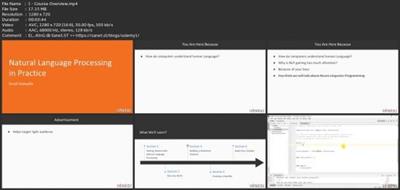
[center]Last updated 4/2019
MP4 | Video: h264, 1280x720 | Audio: AAC, 44.1 KHz
Language: English | Size: 1.11 GB | Duration: 3h 5m
Build smart AI-driven linguistic applications using deep learning and NLP techniques[/center]
What you'll learn
Attain a strong foundation in Python for deep learning and NLP
Build applications with Python, using the Natural Language Toolkit via NLP
Get to grips on various NLP techniques to build an intelligent Chatbot
Classify text and speech using the Naive Bayes Algorithm
Use various tools and algorithms to build real-world applications
Build solutions such as text similarity, summarization, sentiment analysis and anaphora resolution to get up to speed with new trends in NLP
Write your own POS taggers and grammars so that any syntactic analyses can be performed easily
Use the inbuilt chunker and create your own chunker to evaluate trained models
Create your own named entities using dictionaries to use inbuilt text classification algorithms
Requirements
Basic knowledge of NLP and some prior programming experience in Python is assumed. Familiarity with deep learning will be helpful.
Description
Natural Language Processing (NLP) is the most interesting subfield of data science. It offers powerful ways to interpret and act on spoken and written language. It's used to help deal with customer support enquiries, analyse how customers feel about a product, and provide intuitive user interfaces. If you wish to build high performing day-to-day apps by leveraging NLP, then go for this course.This course teaches you to write applications using one of the popular data science concepts, NLP. You will begin with learning various concepts of natural language understanding, Natural Language Processing, and syntactic analysis. You will learn how to implement text classification, identify parts of speech, tag words, and more. You will also learn how to analyze sentence structures and master syntactic and semantic analysis. You will learn all of these through practical demonstrations, clear explanations, and interesting real-world examples. This course will give you a versatile range of NLP skills, which you will put to work in your own applications.Contents and OverviewThis training program includes 2 complete courses, carefully chosen to give you the most comprehensive training possible.The first course, Natural Language Processing in Practice, will help you gain NLP skills by practical demonstrations, clear explanations, and interesting real-world examples. It will give you a versatile range of deep learning and NLP skills that you can put to work in your own applications.The second course, Developing NLP Applications Using NLTK in Python, course is designed with advanced solutions that will take you from newbie to pro in performing natural language processing with NLTK. You will come across various concepts covering natural language understanding, natural language processing, and syntactic analysis. It consists of everything you need to efficiently use NLTK to implement text classification, identify parts of speech, tag words, and more. You will also learn how to analyze sentence structures and master syntactic and semantic analysis.By the end of this course, you will be all ready to bring deep learning and NLP techniques to build intelligent systems using NLTK in Python.Meet Your Expert(s):We have the best work of the following esteemed author(s) to ensure that your learning journey is smooth:Smail Oubaalla is a talented Software Engineer with an interest in building the most effective, beautiful, and correct piece of software possible. He has helped companies build excellent programs. He also manages projects and has experience in designing and managing new ones. When not on the job, he loves hanging out with friends, hiking, and playing sports (football, basketball, rugby, and more). He also loves working his way through every recipe he can find in the family cookbook or elsewhere, and indulging his love for seeing new places.Krishna Bhavsar has spent around 10 years working on natural language processing, social media analytics, and text mining in various industry domains such as hospitality, banking, healthcare, and more. He has worked on many different NLP libraries such as Stanford CoreNLP, IBM's SystemText and BigInsights, GATE, and NLTK to solve industry problems related to textual analysis. He has also worked on analyzing social media responses for popular television shows and popular retail brands and products. He has also published a paper on sentiment analysis augmentation techniques in 2010 NAACL. he recently created an NLP pipeline/toolset and open sourced it for public use. Apart from academics and technology, Krishna has a passion for motorcycles and football. In his free time, he likes to travel and explore. He has gone on pan-India road trips on his motorcycle and backpacking trips across most of the countries in South East Asia and Europe.Naresh Kumar has more than a decade of professional experience in designing, implementing, and running very-large-scale Internet applications in Fortune Top 500 companies. He is a full-stack architect with hands-on experience in domains such as ecommerce, web hosting, healthcare, big data and analytics, data streaming, advertising, and databases. He believes in open source and contributes to it actively. Naresh keeps himself up-to-date with emerging technologies, from Linux systems internals to frontend technologies. He studied in BITS-Pilani, Rajasthan with dual degree in computer science and economics.Pratap Dangeti develops machine learning and deep learning solutions for structured, image, and text data at TCS, in its research and innovation lab in Bangalore. He has acquired a lot of experience in both analytics and data science. He received his master's degree from IIT Bombay in its industrial engineering and operations research program. Pratap is an artificial intelligence enthusiast. When not working, he likes to read about nextgen technologies and innovative methodologies. He is also the author of the book Statistics for Machine Learning by Packt.
Overview
Section 1: Natural Language Processing in Practice
Lecture 1 Course Overview
Lecture 2 Setup and Installation
Lecture 3 Understanding NLP and Its Benefits
Lecture 4 Exploring NLP Tools and Libraries
Lecture 5 Tokenization
Lecture 6 Stop Words
Lecture 7 Part of Speech Tagging
Lecture 8 Stemming and Lemmatization
Lecture 9 Named Entity Recognition
Lecture 10 TF-IDF
Lecture 11 Introduction to Sentiment Analysis
Lecture 12 Pre-Processing the Dataset
Lecture 13 Word Embeddings
Lecture 14 Build the Network
Lecture 15 Train the Model
Lecture 16 Test the Model
Lecture 17 Apply to a Single Input
Lecture 18 Machine Learning
Lecture 19 Classification
Lecture 20 Pre-Processing the Dataset
Lecture 21 Naïve Bayes and SVM
Lecture 22 Train the Classifier
Lecture 23 Test the Classifier
Lecture 24 Chatbots
Lecture 25 Simple NLTK Bot
Lecture 26 Create a ChatterBot
Lecture 27 Enhancing the Chabot
Lecture 28 Training the Chabot
Section 2: Developing NLP Applications Using NLTK in Python
Lecture 29 The Course Overview
Lecture 30 Exploring the In-Built Tagger
Lecture 31 Writing Your Own Tagger
Lecture 32 Training Your Own Tagger
Lecture 33 Learning to Write Your Own Grammar
Lecture 34 Writing a Probabilistic CFG
Lecture 35 Writing a Recursive CFG
Lecture 36 Using the Built-In Chunker
Lecture 37 Writing Your Own Simple Chunker
Lecture 38 Training a Chunker
Lecture 39 Parsing Recursive Descent
Lecture 40 Parsing Shift-Reduce
Lecture 41 Parsing Dependency Grammar and Projective Dependency
Lecture 42 Parsing a Chart
Lecture 43 Using Inbuilt NERs
Lecture 44 Creating, Inversing, and Using Dictionaries
Lecture 45 Choosing the Feature Set
Lecture 46 Segmenting Sentences Using Classification
Lecture 47 Writing a POS Tagger with Context
Lecture 48 Creating an NLP Pipeline
Lecture 49 Solving the Text Similarity Problem
Lecture 50 Resolving Anaphora
Lecture 51 Disambiguating Word Sense
Lecture 52 Performing Sentiment Analysis
Lecture 53 Exploring Advanced Sentiment Analysis
Lecture 54 Creating a Conversational Assistant or Chatbot
This course is for data science professionals who would like to expand their knowledge from traditional NLP techniques to state-of-the-art techniques in the application of NLP.

download скачать link
rapidgator.net:
https://rapidgator.net/file/e68a96ba01a8f9218684de7afbe0a043/lqcrm.Natural.Language.Processing.Nlp.Using.Nltk.In.Python.part1.rar.html https://rapidgator.net/file/26c5398b61342d5bd7c5a04e628bf033/lqcrm.Natural.Language.Processing.Nlp.Using.Nltk.In.Python.part2.rar.html
uploadgig.com:
https://uploadgig.com/file/download скачать/F65C409a065f5A1b/lqcrm.Natural.Language.Processing.Nlp.Using.Nltk.In.Python.part1.rar https://uploadgig.com/file/download скачать/60CBCF4e27507efc/lqcrm.Natural.Language.Processing.Nlp.Using.Nltk.In.Python.part2.rar
nitroflare.com:
https://nitroflare.com/view/181863EEEBB0AD4/lqcrm.Natural.Language.Processing.Nlp.Using.Nltk.In.Python.part1.rar https://nitroflare.com/view/FD039B6DCD2E998/lqcrm.Natural.Language.Processing.Nlp.Using.Nltk.In.Python.part2.rar

